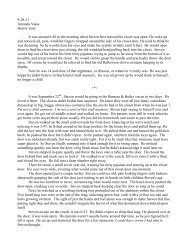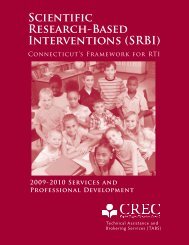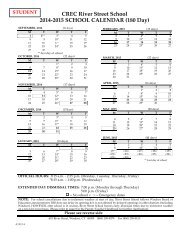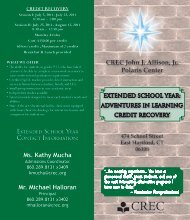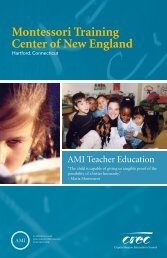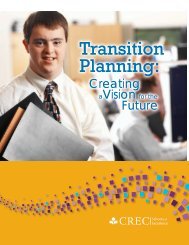Reading and Role Playing: Fiction, Folktales, and Fairy Tale
Reading and Role Playing: Fiction, Folktales, and Fairy Tale
Reading and Role Playing: Fiction, Folktales, and Fairy Tale
Create successful ePaper yourself
Turn your PDF publications into a flip-book with our unique Google optimized e-Paper software.
<strong>Reading</strong> Curricular Calendar, Second Grade, 2012-20137to Partner B as if she’s your teacher. Tell your teacher that you don’t want to go on the bus.”Then, after a few minutes, say, “Partner B, you are the teacher. You are looking at Junie B. Whatare you thinking? Say your thoughts aloud.” Partners could also predict together what mayhappen next based on what they know about their characters so far. Of course, this needn’tinvolve one partner being one character <strong>and</strong> one the other. You might say, “Your right fingerpuppet is Junie B. Junie B., tell your teacher—your left finger-puppet—why you don’t want toride the bus! Then have your teacher finger-puppet talk back.” This work could lead to little bitsof improvisational drama: “Pretend you are Junie B. You are st<strong>and</strong>ing at school, getting ready totalk to your teacher. Your Mom is right beside you. What are you thinking right now? What areyou doing? Turn <strong>and</strong> act.”Bend Two – Directing Ourselves <strong>and</strong> Our Club MatesWe suggest you move children from partnerships to clubs in this second bend of the unit. Notonly will children’s foundational skills (fluency, accuracy) be supported by a larger groupdiscussion, but the additional (sometimes opposing) viewpoints will challenge them to thinkmore critically about books <strong>and</strong> characters. This is integral work to becoming a moresophisticated reader <strong>and</strong> thinker. Now that readers have had practice coming to underst<strong>and</strong>characters through deep empathy <strong>and</strong> envisionment (<strong>and</strong> a little inference), they’ll be ready to liftthe level of their enactments <strong>and</strong> bring out even more emotion. The work they will have done upto now will have been largely close-in role-playing. They will have examined characters byworking their way into one role or another. Now you’ll invite your children to step out of thecharacter’s shoes <strong>and</strong> put on the hat of the director. “Readers, you know how there’s a bigceremony each year that gives out prizes to people who work in movies?” you might say. “Haveyou ever noticed how the director (that’s the person who guides all the actors <strong>and</strong> camera people)gets his or her prize toward the end of the Oscars? That’s because being a director is a really,really big job. So winning best director is a huge deal. Directors have to underst<strong>and</strong> not just howone character feels but how all the characters feel. Directors have to underst<strong>and</strong> the setting, too,<strong>and</strong> the sound <strong>and</strong> visual effects, <strong>and</strong> how the plot twists <strong>and</strong> turns, <strong>and</strong> the ways in which allthese different components come together. Directors have to see the big picture.” Pause for amoment to let this sink in. Then issue an invitation: “Do you know what I think? I think all ofyou are ready to be directors. I’ve watched you these past days <strong>and</strong> noticed how, even as you’redeep into the role of the bully, you’re able to step back <strong>and</strong> say to your partner, ‘I think she’smore scared than that. Try putting your h<strong>and</strong>s over your eyes <strong>and</strong> shaking a little.’ That’sdirecting! You’re noticing not only how different characters feel but also how they might movetheir bodies <strong>and</strong> say their lines—<strong>and</strong> then you’re giving each other little directions or cues. Forthe next week or so, we’re each going to have a turn doing more of this big-picture work.”If you haven’t done so already, you may want to read some fairy tales or folktales aloud. Youcan model how you go about viewing the scenes <strong>and</strong> characters through director’s eyes. “Oh Isee it!” you might exclaim after reading, “Then I’ll huff <strong>and</strong> I’ll puff <strong>and</strong> I’ll blow your housedown!” the third time the wolf in The Three Little Pigs calls it out. “The wolf is getting a bit tirednow. He’s trying to be the same intimidating guy he was earlier, but he’s losing steam.” Thenyou might show kids what that looks like <strong>and</strong> maybe say, “I bet his cheeks are about ready toburst by now. That’s a lot of huffing <strong>and</strong> puffing he’s been doing!” Then you might say, “I bethe’s feeling pretty fed up—<strong>and</strong> hungry, too. If you were directing someone to play the wolf,what would you say to that person? What cues might you give? Turn <strong>and</strong> talk to your partner.”Unit Six – <strong>Reading</strong> <strong>and</strong> <strong>Role</strong> <strong>Playing</strong>: <strong>Fiction</strong>, <strong>Folktales</strong>, <strong>and</strong> <strong>Fairy</strong> <strong>Tale</strong>s<strong>Reading</strong> <strong>and</strong> Writing Project, 2012 ©DRAFT





